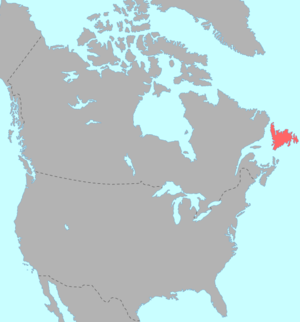Beothuk language
| Beothuk | |
|---|---|
| Beothukan | |
| Native to | Canada |
| Region | Newfoundland |
| Ethnicity | Beothuk people |
| Extinct | 1829, with the death of Shanawdithit (Nancy April) |
|
unclassified | |
| Language codes | |
| ISO 639-3 |
bue |
Linguist list |
bue |
| Glottolog |
beot1247[1] |
|
Pre-contact distribution of Beothuk language | |
The Beothuk language (/biːˈɒtək/ or /ˈbeɪ.əθʊk/), also called Beothukan, was spoken by the indigenous Beothuk people of Newfoundland. The Beothuk have been extinct since 1829 and there are few written accounts of their language, so little is known about it. There have been claims of links with the neighbouring Algonquian language family but there is not enough evidence to draw strong conclusions.[2] In 2007 DNA studies showed genetic links between the Beothuk people and Algonquian-speaking Mi'kmaq.[3]
Beothuk is known only from four word lists written down in the 18th and 19th centuries. They contain more than 400 words but no examples of connected speech. Claims of Beothuk's link with Algonquian languages date back at least to Robert Latham in 1862. From 1968 onwards John Hewson has put forth evidence of sound correspondences and shared morphology with Proto-Algonquian. However, a lack of any systematic or consistent representation of the vocabulary in the wordlists makes it daunting to establish what the sound system of Beothuk was, and words listed separately on the lists may be the same word transcribed in sundry ways. Moreover, the lists are known to have many mistakes. This, along with the lack of connected speech leaves little upon which to build any reconstruction of Beothuk. Owing of this overall lack of meaningful evidence, Ives Goddard and Lyle Campbell claim that any connections between Beothuk and Algonquian are unknown and likely unknowable.[4]
In 1910 American anthropologist Frank Speck recorded a seventy-five-year-old native woman named Santu Toney singing a song purported to be in the Beothuk language. The recording resurfaced at the very end of the twentieth century. Some sources give the year 1929, but the 1910 date is confirmed in Speck's book Beothuk and Micmac (New York 1922, p. 67). The words are hard to hear and not understood. Santu said she had been taught the song by her father (which may be evidence that one person with a Beothuk connection was alive after the death of Shanawdithit in 1829, given Santu Toney was born about 1835). Contemporary researchers have tried to make a transcription of the song along with hoping to clean up the recording with modern methods. Native groups have learned the song.[5]
Mr. James P. Howley, Director of the Geological Survey of Newfoundland, who for more than forty years was interested in the history of the Beothuk, doubted (in 1914) the truthfulness of Santu Toney.[6]
References
- ↑ Nordhoff, Sebastian; Hammarström, Harald; Forkel, Robert; Haspelmath, Martin, eds. (2013). "Beothuk". Glottolog. Leipzig: Max Planck Institute for Evolutionary Anthropology.
- ↑ Mithun, Marianne (2001). The Languages of Native North America (First paperback ed.). Cambridge, United Kingdom: Cambridge University Press. p. 368. ISBN 0-521-23228-7.
- ↑ Maelanie Kuch, et al. (2007), "A preliminary analysis of the DNA and diet of the extinct Beothuk: A systematic approach to ancient human DNA" PDF (510 KB), American Journal of Physical Anthropology 132:594-604, accessed 18 Feb 2009
- ↑ Campbell, Lyle (1997). American Indian Languages: The Historical Linguistics of Native America. Oxford University Press. p. 290. ISBN 0-19-509427-1.
- ↑ Perry, SJ (2008-09-10). "Santu’s Song: Memorable day for Beothuk Interpretation Centre". Porte Pilot. Retrieved 2010-01-13.
- ↑ Santu’s Song | Hewson | Newfoundland and Labrador Studies
